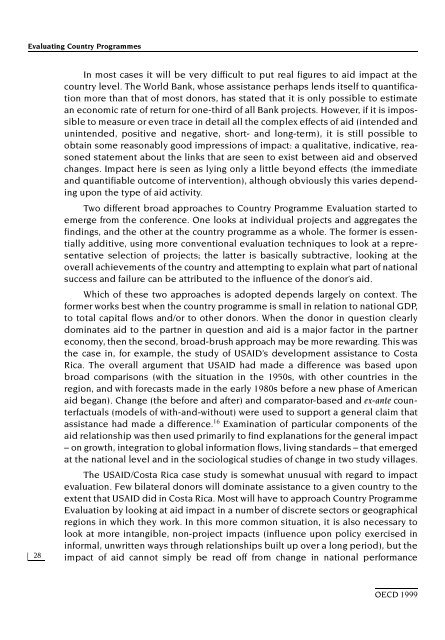Evaluating Country Programmes - OECD Online Bookshop
Evaluating Country Programmes - OECD Online Bookshop
Evaluating Country Programmes - OECD Online Bookshop
You also want an ePaper? Increase the reach of your titles
YUMPU automatically turns print PDFs into web optimized ePapers that Google loves.
<strong>Evaluating</strong> <strong>Country</strong> <strong>Programmes</strong><br />
28<br />
In most cases it will be very difficult to put real figures to aid impact at the<br />
country level. The World Bank, whose assistance perhaps lends itself to quantification<br />
more than that of most donors, has stated that it is only possible to estimate<br />
an economic rate of return for one-third of all Bank projects. However, if it is impossible<br />
to measure or even trace in detail all the complex effects of aid (intended and<br />
unintended, positive and negative, short- and long-term), it is still possible to<br />
obtain some reasonably good impressions of impact: a qualitative, indicative, reasoned<br />
statement about the links that are seen to exist between aid and observed<br />
changes. Impact here is seen as lying only a little beyond effects (the immediate<br />
and quantifiable outcome of intervention), although obviously this varies depending<br />
upon the type of aid activity.<br />
Two different broad approaches to <strong>Country</strong> Programme Evaluation started to<br />
emerge from the conference. One looks at individual projects and aggregates the<br />
findings, and the other at the country programme as a whole. The former is essentially<br />
additive, using more conventional evaluation techniques to look at a representative<br />
selection of projects; the latter is basically subtractive, looking at the<br />
overall achievements of the country and attempting to explain what part of national<br />
success and failure can be attributed to the influence of the donor’s aid.<br />
Which of these two approaches is adopted depends largely on context. The<br />
former works best when the country programme is small in relation to national GDP,<br />
to total capital flows and/or to other donors. When the donor in question clearly<br />
dominates aid to the partner in question and aid is a major factor in the partner<br />
economy, then the second, broad-brush approach may be more rewarding. This was<br />
the case in, for example, the study of USAID’s development assistance to Costa<br />
Rica. The overall argument that USAID had made a difference was based upon<br />
broad comparisons (with the situation in the 1950s, with other countries in the<br />
region, and with forecasts made in the early 1980s before a new phase of American<br />
aid began). Change (the before and after) and comparator-based and ex-ante counterfactuals<br />
(models of with-and-without) were used to support a general claim that<br />
assistance had made a difference. 16 Examination of particular components of the<br />
aid relationship was then used primarily to find explanations for the general impact<br />
– on growth, integration to global information flows, living standards – that emerged<br />
at the national level and in the sociological studies of change in two study villages.<br />
The USAID/Costa Rica case study is somewhat unusual with regard to impact<br />
evaluation. Few bilateral donors will dominate assistance to a given country to the<br />
extent that USAID did in Costa Rica. Most will have to approach <strong>Country</strong> Programme<br />
Evaluation by looking at aid impact in a number of discrete sectors or geographical<br />
regions in which they work. In this more common situation, it is also necessary to<br />
look at more intangible, non-project impacts (influence upon policy exercised in<br />
informal, unwritten ways through relationships built up over a long period), but the<br />
impact of aid cannot simply be read off from change in national performance<br />
<strong>OECD</strong> 1999

















![CQE=U]^\]Z: KAZAKHSTAN - OECD Online Bookshop](https://img.yumpu.com/3915768/1/190x253/cqeuz-kazakhstan-oecd-online-bookshop.jpg?quality=85)